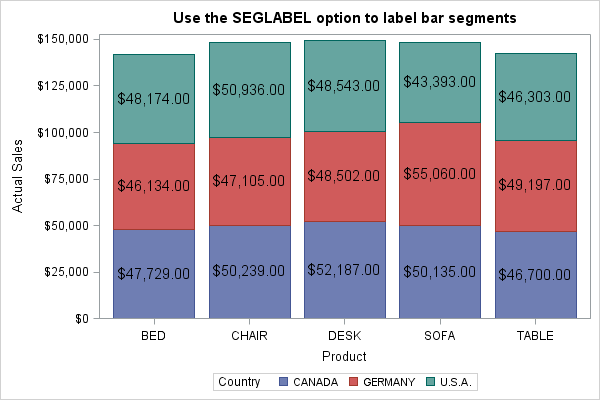Sample 55866: Use the SEGLABEL option to label bar segments in a bar chart
The sample code on the Full Code tab uses the SEGLABEL option in the VBAR statement in PROC SGPLOT to add labels in each bar segment. This sample requires the second maintenance release of SAS® 9.4 (TS1M2).
These sample files and code examples are provided by SAS Institute
Inc. "as is" without warranty of any kind, either express or implied, including
but not limited to the implied warranties of merchantability and fitness for a
particular purpose. Recipients acknowledge and agree that SAS Institute shall
not be liable for any damages whatsoever arising out of their use of this material.
In addition, SAS Institute will provide no support for the materials contained herein.
The sample code below uses the SEGLABEL option to place labels in the segments of a bar chart. This sample requires the second maintenance release of SAS 9.4 (TS1M2).
ods graphics / reset width=600px height=400px imagefmt=png imagename='BarChart';
title "Use the SEGLABEL option to label bar segments";
proc sgplot data=sashelp.prdsale;
vbar product / group=country response=actual seglabel seglabelattrs=(size=12);
run;
These sample files and code examples are provided by SAS Institute
Inc. "as is" without warranty of any kind, either express or implied, including
but not limited to the implied warranties of merchantability and fitness for a
particular purpose. Recipients acknowledge and agree that SAS Institute shall
not be liable for any damages whatsoever arising out of their use of this material.
In addition, SAS Institute will provide no support for the materials contained herein.

This sample uses the SEGLABEL option to place labels in segments of a bar chart created with PROC SGPLOT.
| Type: | Sample |
| Topic: | SAS Reference ==> Procedures ==> SGPLOT
|
| Date Modified: | 2015-06-04 10:52:46 |
| Date Created: | 2015-05-26 09:23:08 |
Operating System and Release Information
| SAS System | Base SAS | Microsoft Windows 8 Enterprise x64 | 9.4 TS1M2 | |
| Microsoft Windows 8 Pro 32-bit | 9.4 TS1M2 | |
| Microsoft® Windows® for x64 | 9.4 TS1M2 | |
| Microsoft Windows 8 Enterprise 32-bit | 9.4 TS1M2 | |
| Microsoft® Windows® for 64-Bit Itanium-based Systems | 9.4 TS1M2 | |
| z/OS | 9.4 TS1M2 | |
| Z64 | 9.4 TS1M2 | |
| Microsoft Windows 8 Pro x64 | 9.4 TS1M2 | |
| Microsoft Windows 8.1 Enterprise 32-bit | 9.4 TS1M2 | |
| Microsoft Windows 8.1 Enterprise x64 | 9.4 TS1M2 | |
| Microsoft Windows 8.1 Pro | 9.4 TS1M2 | |
| Microsoft Windows 8.1 Pro 32-bit | 9.4 TS1M2 | |
| Microsoft Windows Server 2008 | 9.4 TS1M2 | |
| Microsoft Windows Server 2008 R2 | 9.4 TS1M2 | |
| Microsoft Windows Server 2008 for x64 | 9.4 TS1M2 | |
| Microsoft Windows Server 2012 Datacenter | 9.4 TS1M2 | |
| Microsoft Windows Server 2012 R2 Datacenter | 9.4 TS1M2 | |
| Microsoft Windows Server 2012 R2 Std | 9.4 TS1M2 | |
| Microsoft Windows Server 2012 Std | 9.4 TS1M2 | |
| Windows 7 Enterprise 32 bit | 9.4 TS1M2 | |
| Windows 7 Enterprise x64 | 9.4 TS1M2 | |
| Windows 7 Home Premium 32 bit | 9.4 TS1M2 | |
| Windows 7 Home Premium x64 | 9.4 TS1M2 | |
| Windows 7 Professional 32 bit | 9.4 TS1M2 | |
| Windows 7 Professional x64 | 9.4 TS1M2 | |
| Windows 7 Ultimate 32 bit | 9.4 TS1M2 | |
| Windows 7 Ultimate x64 | 9.4 TS1M2 | |
| 64-bit Enabled AIX | 9.4 TS1M2 | |
| 64-bit Enabled HP-UX | 9.4 TS1M2 | |
| 64-bit Enabled Solaris | 9.4 TS1M2 | |
| HP-UX IPF | 9.4 TS1M2 | |
| Linux for x64 | 9.4 TS1M2 | |
| Solaris for x64 | 9.4 TS1M2 | |





